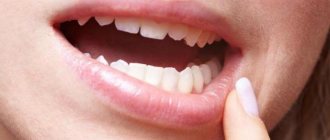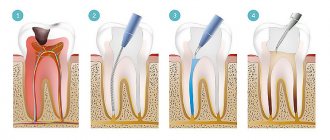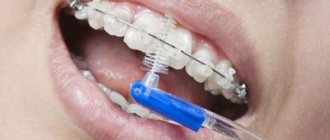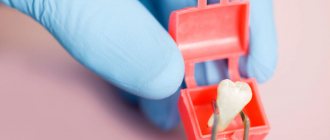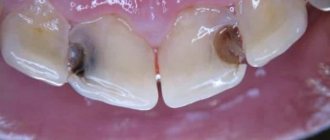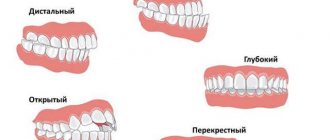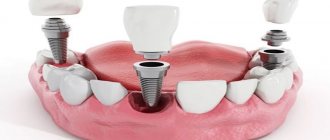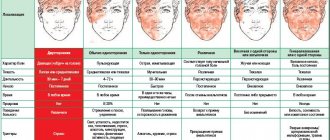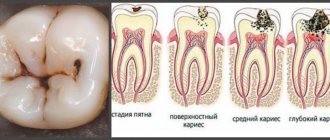Many of us have encountered such an unpleasant sensation as toothache, which appears for various reasons, but the most common of them is the patient’s improper care of his oral cavity. As a result, severe damage to the teeth occurs. If there are serious pathologies, a pin is placed on the tooth. The reason for this is the beginning of the destruction of the crown. Because of this, additional support is required to help with subsequent recovery.
A tooth with a pin without a nerve hurts
What should someone do if a tooth with a pin without a nerve hurts? Let's find out in the article.
About the dental post
A dental pin is a structure made from a special impression. It is installed in a previously prepared root canal of the tooth. The pin is used as a support for dentures.
The pin is installed in the root canal of the tooth
It is worthwhile to dwell in more detail on the classification of rods that strengthen damaged teeth. Since there are a large number of pins and each of them has its own characteristics, it will be extremely important to understand and not get confused in all the diversity.
Remember ! Only the attending dentist decides which pin would be appropriate to use in each possible case.
First of all, there is a classification of pins according to the material from which they are made.
- Metal pins (also called anchor pins) are installed more often than others. Typically made from surgical steel, titanium, as well as platinum, gold and other various alloys.
- Carbon fiber is used as the material for the pins. Such rods are called elastic. Their characteristics are close to the natural dentin layer.
- Fiberglass posts are also very flexible and also have translucent properties - a big plus when placing them on the front teeth.
- Pins made of metal alloys with a polymer coating are called parapulpal. Usually they are installed not at the root of the tooth, but as a supporting structure.
- Another material for rods is gutta-percha. It is good for its environmental friendliness. Pins made from this material are much cheaper than others, but their service life is still shorter.
- Individual stump inlays. They are usually placed when the crown is completely destroyed.
There are several types of pins
There is also a classification based on the method of attachment to the tooth. According to it, the pins can be divided into:
- active pins - secured to threads for strength and durability;
- passive - installed in the tooth canal using a fixing solution. They do not last as long and are used for serious damage and expansion of the tooth canals.
According to the fastening method, pins can be divided into screw, cylindrical and conical.
There are also several types of pins according to the method of fastening
In what cases is a pin placed?
Dentists prescribe pin implantation when the crown is destroyed by more than 50%. In this way, the thinned walls are strengthened. The pin is also installed when building up stumps for artificial crowns.
In what situations is it not recommended to install a pin:
- the periodontium does not hold the tooth well;
- small root size;
- root caries damage
- the channel is perforated;
- cysts were diagnosed at the roots;
- for blood diseases;
- The walls of the tooth root are very thin.
There are situations when the installation of pins is contraindicated
Why do you need a pin and the process of installing it?
When the tooth crown is destroyed by more than half, root pins are used. They are a reinforcing base on which the composite material is then built up. The pin has the following advantages:
- The root of the tooth can be restored.
- Saving money on a prosthesis (cheaper than prosthetics).
- There is no risk of allergies.
- Helps in building up a tooth with removed pulp.
A dental post is necessary for tooth extension - this is the main direction of its use. It is fixed in a previously disinfected root canal and serves as a support for the crown. For the installation to be successful, you must adhere to the following conditions:
- The thickness of the root wall should be at least 3 mm.
- It should be possible to unseal half of its length.
- Fully obturated canal.
- Making the design cylindrical or conical in shape.
Advantages and disadvantages
Positive aspects of the installation:
- a decaying tooth retains its shape;
- in the future, you can build up the tooth stump to install ceramic crowns;
- it becomes possible to restore the enamel;
- This way you can prevent tooth extraction;
- The pins are durable and should be replaced no earlier than every ten years.
There are many advantages to high-quality installation of pins
The disadvantages of this design include the following:
- the pin can become one of the causes of tooth decay;
- if the rod is installed incorrectly, it can cause caries;
- metal pins are susceptible to corrosion from external factors;
- allergies and pin rejection may occur;
- over time, the walls of the tooth become thinner, which leads to the subsequent removal of damaged teeth;
- installing a pin is a fairly expensive procedure, especially when using modern materials.
Unfortunately, there are also negative aspects to such a procedure.
Why does pain occur after installation?
The causes of pain with a pin installed cannot be identified on your own. If you notice that after implantation the tooth area begins to hurt, be sure to make an appointment with a doctor.
Pain occurs due to unprofessional or erroneous actions of the dentist.
- The pin is set too deep. The pain is felt during physical impact (for example, chewing) and has an aching character.
- During installation, the dental canal was cleaned with errors, and the walls of the tooth were damaged.
- The filling material has not completely filled the root canal. It could also simply extend beyond the apical foramen.
- When a fragment or several fragments are found in the canal belonging to endodontic instruments.
- In case of poorly performed disinfection of the canal during the procedure.
There are many reasons why pain occurs after insertion of a pin.
Important ! When installing the pin, the doctor requires high concentration.
During cleaning, it is necessary to use all the necessary instruments and identify the position of the apical foramen. To monitor the condition, an additional x-ray is prescribed.
In addition to incorrectly performed medical procedures, there may be other causes of painful sensations.
Normally, aching pain in a tooth can last up to several days; over time it subsides and disappears completely. Sometimes the pain is associated with an allergy, when the body does not accept the material from which the pin is made. In such cases, x-rays usually show the real picture.
Some discomfort after the procedure is normal.
If pain is not observed immediately after the intervention, but after a long period, for example, after several years, then the reasons that led to its occurrence may be as follows.
- Failure to maintain proper oral hygiene.
- Minor damage to tooth tissue (usually occurs due to biting nuts and other hard objects, opening lids with teeth, etc.).
- Periodontal inflammation.
- The appearance of cysts on the roots of teeth.
- Serious tissue damage.
Video - Dentist about pain in a tooth without a nerve
Causes of pain
Only an x-ray can help to understand why a patient’s tooth hurts after installing a pin. Sometimes the reason lies in the unprofessional work of a specialist:
- The root canal was damaged by a metal instrument, causing a hole to form in it.
- The doctor placed the pin incorrectly. If the product has been screwed in too deeply, it may rest against the bone, and the tooth will hurt when pressing and chewing, and due to prolonged stress, it may continue to ache even after finishing eating. The intensity of discomfort depends on the complexity of the case.
- Insufficient filling of the canals with filling material.
- Poor quality antiseptic treatment. The bacteria remaining in the root contribute to the development of inflammation, which provokes the appearance of an abscess. If left untreated, an abscess or fistula may develop in the gum.
- The presence of a fragment of a dental instrument in the root.
- Filling material getting beyond the root apex. As a result, there is constant irritation of the soft tissues surrounding the unit, and the patient feels pain when pressed.
Pain in a tooth with a pin can be caused by other reasons:
- carrying out complex treatment;
- allergy to the material of the rod (in parallel, gum hyperemia and stomatitis occur);
- high-mounted seal;
- increased sensitivity by nature (manifests itself when consuming hot/cold and solid foods).
If a patient complains of pain in a long-restored tooth, the causes of discomfort may be:
- insufficient hygiene;
- periodontitis;
- destruction of roots;
- cyst formation;
- presence of microcracks in the unit;
- gum damage.
Symptoms
Complications are expressed by the following symptoms.
- Pain due to external impact on the tooth (pressure or chewing) or eating too hot or cold food (has aching character).
- Swelling of the gums.
- Fever, nausea and weakness.
If the pin is not installed correctly, the person's condition may worsen greatly.
Important ! The latter symptoms may indicate the cause of complications after the installation of the pin - allergies.
Installing a pin is a good way to preserve tooth health for at least five to six years. Unfortunately, conventional fillings cannot completely solve the problem of serious damage to dental tissue. The pin installation procedure is painless, and using the latest generation materials can significantly reduce the likelihood of complications.
However, sometimes complications still arise. What could they be?
It was mentioned above that pain often occurs after implantation of the rod. Its reasons are different.
It happens that the dentist did not approach the process of installing the rod professionally enough. The reasons are:
- too deep implantation when the pin comes into contact with the bone;
- the walls of the teeth are damaged, the root canals are perforated;
- small amount of filling material;
- debris of dental instruments entering the tooth canal;
- acute pain may appear due to purulent formation, which leads to swelling of nearby tissues;
- if severe inflammation begins, this is fraught with the occurrence of fistulas due to the effect of purulent discharge on the mucous membranes and gums;
- if the patient has chronic periodontitis, there is a risk of cysts.
If the doctor does not install the pin properly, the patient will experience great discomfort.
Another common cause of pain after a pin is inserted is an allergy to the material from which the pin was made. Signs that the body does not perceive the structure well may include weakness combined with elevated body temperature, as well as inflammation in the oral cavity. Complications also arise when there is insufficient attention to hygiene procedures, for example, brushing the teeth and oral cavity.
Advantages and Disadvantages of Pin Installation
Arguments for":
- The main advantage of using pins is the ability to restore the hard tissue of the tooth completely, even with severe destruction. In this case, the tooth does not have to be replaced with crowns, dentures or implants. The pin helps restore the tooth completely and also restore the ability to chew. In addition, from an aesthetic point of view, the tooth is also restored and looks healthy.
- The use of a pin design allows you to preserve the root system of the tooth without allowing a foreign body to touch the mucous membrane. This is especially important for people who are intolerant to certain materials.
- Another advantage of this technique is its long service life. Typically, post manufacturers and dentists provide a 10-year warranty. However, as practice shows, in fact the pins can remain intact much longer. If there is no heavy load and hygiene standards are observed, the rods can last up to 20 years without replacement.
- Today, medicine uses a large number of different pins, which may differ in material, color and size. This makes it possible to select a design depending on the individual characteristics of the patient, so that it best suits the size of the tooth and other conditions.
- Even in cases where the pin is chosen for a prosthesis made of ceramic, a material that appears translucent in appearance, the optimal option can be selected. In this case, metal rods, as a rule, are not used, since they are visible, which spoils the aesthetic effect. For ceramics, it is best to use fiberglass rods; they are less noticeable and allow you to maintain a beautiful smile.
Flaws:
There are also disadvantages to the pin placement procedure.
- If the work is done poorly, caries may form around the rod in the tooth. With this design, it is extremely difficult to detect the onset of the development of the disease, since the patient does not experience pain due to the absence of nerve endings, and from the outside the tooth is closed by the rod itself. Therefore, for a long time it is impossible to understand that caries has appeared in a tooth.
- If there is a strong impact on the teeth, displacement of the rod may occur. This, in turn, threatens damage to the prosthesis or expansion of the hole in which the rod is fixed. In this case, patients experience severe pain. In most such cases, if any complications arise, the patient is prescribed surgery to remove the pin structure along with the root part.
- In addition, you should understand that over time the rod will wear away the tooth, and in any case it will have to be removed. In such situations, removal is only possible completely, along with the root part of the tooth. As a result, the patient will still need an implant.
- There is another disadvantage of the pin installation procedure - its cost. Of course, installing implants or prostheses may require more money, however, the pin design is also not cheap, and not everyone can afford it.
How does the installation take place?
When preparing for the procedure, many patients wonder how exactly the intervention will take place. The complex of restorative actions is divided into two conventional stages - directly working with the pin and the process of restoring the tooth through prosthetics.
Important ! How the pin will be installed depends primarily on its type and material.
However, the procedure is usually unchanged. It must always be observed, no matter what teeth the pins are installed on: incisors, canines, molars or premolars.
How the pin is installed depends on many things
Accordingly, actions are performed in this order.
First of all, the patient is examined by a dentist. If concomitant conditions are discovered that may adversely affect the result, they must be pre-treated. Thus, you first need to cure caries and other pathologies of the oral cavity and teeth. In order to avoid complications caused by bacterial damage, professional sanitation of the oral cavity is performed.
An X-ray of the decayed tooth is also taken. Based on the information from the image, the dentist determines the characteristics of the tooth: length, angle of inclination and root diameter.
Next, the doctor determines which pin will be installed and how. On the appointed day before installing the rod, it is better not to eat food.
The intervention is carried out after the administration of local anesthesia: it is injected into the gum next to the damaged tooth. As soon as it begins to act, the procedure itself is carried out.
The intervention is performed under local anesthesia
The dental canals are thoroughly cleaned. To do this, drills are used, usually small in size, so as not to accidentally damage the canal and cause the formation of cracks and other damage. If necessary, expand the channel.
Interesting ! A filling is usually placed at the top of the root.
If a passive pin is installed, a cementing mixture is placed into the canal. A pin is placed in it, and it is thoroughly dried using a special dental lamp.
Next, the dentist conducts a control check and schedules the next appointment for further prosthetics.
The dentist himself sets the time for the next appointment
How to build teeth onto pins, what is this process?
Prosthetics are performed after the pin is installed. Nowadays in dentistry, modern materials are used to make prosthetics; crowns are installed, as well as bridge prostheses if several teeth have been damaged at once.
First, the doctor must shape the filling material into the tooth around the post. It is shaped, filed and polished. What the result will be depends primarily on the experience of the dentist who works with this problem.
If the tooth is seriously damaged, a crown is installed. It is a special prosthesis that cannot be removed and is performed individually for each patient. Usually the cost of crowns is quite high.
If the tooth is seriously damaged, a crown is installed
The entire prosthesis imitates a damaged tooth. It is fixed on the pin using a special strengthening solution. After the crown is installed, some time must pass. Then the doctor checks whether her body rejects it or not. Implantation is considered successful if the prosthesis is installed tightly and there are no signs of inflammation.
Pain on pressure
Sometimes, with external mechanical influence (chewing, pressure), a feeling of pain may occur. This happens quite often, since the treatment process is quite complex, an artificial crown is installed. After some time, the pain goes away.
Another reason that causes pain when pressure is placed on a tooth is when the filling is placed too high. As a result, the jaw stops closing normally. Most often, pain of this nature occurs when chewing food. For prevention, it is recommended to remain under observation in the hospital for some time to understand whether there are any new unpleasant sensations after the intervention.
Sometimes after installing the pin, if you put pressure on the tooth, you can feel pain
Other causes of pain
One of the common causes of pain is the development of inflammation. This process begins approximately 1-2 days after the pin is installed and may indicate that the soft tissue was damaged during the procedure and became infected. In the oral cavity, infection occurs quite quickly, so you should not postpone a visit to the doctor for treatment - this is fraught with complications.
There is also such a thing as congenital tooth sensitivity. Usually the patient is aware of this peculiarity. Pain occurs, for example, due to chewing hard food or when eating food that has a contrasting temperature (very cold or hot).
Interesting ! The pain occurs due to congenital sensitivity of the teeth.
Solution
What to do if it hurts to chew with a “repaired” tooth or even in a calm state it aches, throbbing pain occurs, or a reaction to cold (hot) food: seek medical help at the dentist. The doctor should warn the patient in advance that discomfort in the area of the filled tooth may persist for the next 3-5 days. He will also give recommendations on how to properly care for the oral cavity and minimize discomfort when it occurs.
You should not put excessive functional load on the “repaired” unit (chew hard food). If the nerve had to be removed during treatment and, in general, difficult manipulations were performed, the doctor may prescribe the patient to take painkillers (you should not abuse them).
Read also: How long does a filling last in a tooth?
If a tooth begins to loosen or a pin (filling) falls out, you must immediately visit a dentist to restore the “damaged” unit. The specialist will send you for an x-ray - the doctor may have to do the whole job again - clean the canals, “mount” the pin, put in a fresh filling.
The fact that a tooth with a pin has become loose may lead to the need for more serious medical intervention:
- extraction of the “repaired” unit (carried out when the canal is perforated with a dental instrument);
- antibacterial therapy (in the presence of an inflammatory process);
- resection (indication – suppuration of the soft tissues surrounding the tooth in case of secondary infection).
So, toothache after filling with the installation of a pin can be quite normal when it lasts no more than 3-5 days and gradually subsides. In all other cases, discomfort indicates the development of a pathological process, poorly performed work by the dentist or post-filling complications - all this should serve as a reason for a second visit to the doctor.
Ways to get rid of pain
Under no circumstances should you delay a visit to the doctor if you experience prolonged or progressive pain after installing the pin. The doctor will conduct a full examination, determine the cause and prescribe appropriate therapy. Usually, fluoridation of tooth enamel or building up a layer of enamel using filling material is prescribed.
Fluoridation of tooth enamel
If the examination shows that everything is in order with the installation of the pin, and the pain occurs on a tooth that is devoid of a nerve, most likely the cause is congenital sensitivity. The patient can cope with it independently, using a special toothpaste with a high content of calcium and fluoride. It is also recommended to use dental floss to remove food debris that causes discomfort and irritation.
When installing a dental pin, it is recommended to rinse your mouth with soda. For about three days, mechanical influences on the tooth from the outside are prohibited; you cannot touch it while chewing. You can take analgesics and apply cold compresses to relieve pain after the procedure.
It is recommended to rinse your mouth with baking soda
What to do if your teeth start to hurt?
Patients faced with the need to install a knitting needle are confident that the tooth should not hurt after the procedure; it does not have nerve endings.
And when unpleasant sensations arise after the operation, people begin to think that the doctor made a mistake and a complication has developed. Sometimes this happens, but tooth or gum pain is the body’s reaction to injury or a stressful situation. Discomfort, pain, swelling of the gums or cheeks, headaches are normal and can last from 1 day to a week. All these unpleasant symptoms can be eliminated if you follow the recommendations:
- For the first 3-4 days, you can rinse your mouth with a soda solution: 1 teaspoon of soda per glass of warm water. You can add a few drops of iodine.
- For 5 days after the procedure, you should give preference to soft foods, without using a pin tooth while chewing.
- If you have increased sensitivity, it is recommended to choose a toothpaste that contains fluoride and calcium.
- If irritation is caused by food particles, they should be carefully removed.
- To eliminate toothache, you can apply cold to the damaged area or use an anesthetic drug: Nurofen, Analgin, Ketanov. But it is recommended to take painkillers only as a last resort.
- You can relieve pain by applying propolis to the affected area, which has an anesthetic and freezing effect.
Do you feel nervous before visiting the dentist?YesNo
If the pain does not go away after 5-7 days or only gets worse, then you need to contact your doctor again to diagnose the problem. Depending on what caused the pain, antibiotic therapy, resection, re-filling or tooth extraction may be prescribed.
Removing a dental post
The pin is removed in the following situations:
- if the apical part of the root becomes inflamed;
- when a filling needs to be replaced;
- during the preparatory stage before implantation;
- with unprofessional and poor-quality installation of the pin.
Removal of the pin is carried out in several stages. First, old fillings, crowns and other structures installed earlier are removed. Then, using ultrasound, the cement holding the pin is destroyed.
After this, you can directly remove the pin using forceps.
Important! If the pin is very firmly fixed in the root canal of the tooth, then ultrasound treatment is performed - due to vibrations, the pin moves, and this makes it easy to remove it.
After the procedure is completed, the doctor must check the patency of the root canals.
The doctor will definitely check if everything is in order after the procedure.
The pins are removed painlessly; this procedure does not pose any danger to the patient. Even anesthesia is not used in this case - only vibration and light pressure are felt.
Possible causes of pain after depulpation
The most common causes of pain after depulpation include:
- Aching pain appears within 2-4 hours after the end of the procedure and occurs due to the cessation of anesthesia. Natural pain. They are short-term in nature and occur with low intensity. Aching pain appears within 2-4 hours after the end of the procedure and occurs due to the cessation of anesthesia; it is unpleasant and painful to press on the tooth.
- Dentist's mistake. When performing depulpation, the doctor may make mistakes. The most common is violation of antiseptic rules, due to which bacteria penetrate under the filling. They provoke an inflammatory process that causes toothache.
- Periodontitis. Pathology accompanied by inflammation of tissue near the roots of the tooth. As a rule, it acts as a complication of pulpitis. It is accompanied by intense pain when pressed, tissue swelling, and at a later stage – the appearance of a purulent formation.
- Partial depulpation. Sometimes the tissues that form the pulp are not completely removed from the roots, as a result of which pain sensitivity remains after cleaning. In such cases, the procedure must be repeated.
- Pinched trigeminal nerve. When treating back teeth, trigeminal nerve anesthesia is often used. If the injection is performed incorrectly, neuralgia may develop, which is accompanied by intense symptoms, including toothache when pressed.
- Perforation of the channel. It is a disorder in which a hole appears in the root canal. As a rule, this happens due to a mistake by the dentist while cleaning the canals. Perforation leads to tissue infection and further development of inflammation.
- Allergy. Pain may occur due to an allergic reaction that occurs to certain components in the filling material. The reaction may also occur due to the effects of anesthesia.
We suggest you familiarize yourself with a sweetish taste in the mouth, what is it
Thus, toothache after removal of the nerve when biting can occur due to numerous postoperative complications.
After installing a dental post
As we have already noted, after a rod has been installed or a crown has been built up, pain is normal for some time. Usually this condition goes away after three days.
However, if you notice that the pain lasts longer or does not subside, but only intensifies, you should immediately visit a dentist. This may indicate damage to the roots of the teeth or the pin being installed too deeply when it comes into direct contact with the bone tissue. The cause can only be determined using an x-ray.
If the pain does not go away for more than three days, you should consult a doctor.
Important! Some patients may be allergic to the material from which the pin is made - then we are talking about symptoms such as redness or swelling. This condition should not be neglected under any circumstances; complications such as serious inflammation - stomatitis or periodontitis - may occur.
After the pin is installed, the patient is recommended to follow a certain regimen to help him recover faster after the intervention. These recommendations should be followed for approximately two weeks.
- Give preference to soft foods to avoid stress on your teeth.
- The toothbrush should be replaced with one with the softest bristles.
- The first time after installing the pin, you should not use electric toothbrushes, toothpicks or dental floss in the area of the tooth where the rod is installed.
- Smoking should be avoided for at least one day after the pin is installed.
- Regularly use a mouth rinse solution prescribed by a specialist.
- Physical activity is minimized or eliminated completely.
- You must strictly adhere to the treatment prescribed by your dentist.
It is important to follow your dentist's recommendations
To prevent and strengthen the immune system, immunostimulants, for example, Imudon, are often prescribed before and after intervention. This drug has proven itself as a means of strengthening local immunity and protecting against infections and inflammation after the procedure.
"Imudon" is indicated for use by children over three years of age and adults. It has a convenient form of administration - these are lozenges with mint flavor.
"Imudon"
Tooth with pin hurts
- After the pin is installed, the patient often feels that the tooth on the pin hurts. This is due to the fact that during the process of tooth restoration, soft tissues are affected. Pain may be caused by the rod entering the root canal deeply.
- If a tooth with a pin hurts immediately after removal of the nerve, then this is natural and the painful sensations will persist for several days. The pain should decrease every day. If, on the contrary, it intensifies, you should urgently consult a doctor.
- Pain may result from an allergic reaction to the material from which the pin is made. In this case, the pain is combined with such manifestations of allergies as hyperemia, stomatitis and deterioration of well-being.
- In any case, if you have a pin installed and your tooth hurts, you should not cancel your visit to the dentist. He will conduct an examination, take an x-ray if necessary, and explain the causes of the pain.
Standard pins have the following analogues:
Photo: stump pin insert
- Stump cast inlays. Cast pin structures are monoblocks and made of one material. Twenty years ago, these structures were used to restore the crown-root sections of teeth. They have now been replaced by standard pins.
- Luminex technology, which combines the advantages of standard pin designs and cast core inlays. In this case, standard titanium pins and analogue light conductors are used.
- Creation of a stump without pins.
- Individual pins - stump inlays are more reliable than standard pin structures, which have sufficient ability to be fixed in almost hopeless roots.
- Collapsible individual pin designs. They are installed on severely damaged chewing teeth, which, after restoration, can bear significant load.
protezi-zubov /protezy/shtift-v-zube/» protezi-zubov
Is it painful to place the pin?
Very often, those who are facing complex dental restorations wonder whether it hurts to install a pin. The question is logical, because the structure is installed deep into the dental canal and is often attached to the dentin. When some people learn about this, they imagine painful and unpleasant sensations.
However, there is nothing to be afraid of. Modern anesthesia and treatment methods prevent any pain.
Let's sum it up
Pain after insertion of a pin occurs for various reasons, but moderate pain is normal. The maximum time through which they must pass is up to five days. If the pain lingers for a longer period of time, it is necessary to consult a doctor who will find out what caused the pain.
However, if erroneous and unprofessional actions of the dentist were noticed, which include installing the rod too deeply, non-compliance with the rules for filling the root canals, damage to them with dental instruments, an incorrectly fixed pin and pieces of dental instruments accidentally left in the canal, then the pain is usually very intense and you need to get rid of it only after consulting a doctor.

